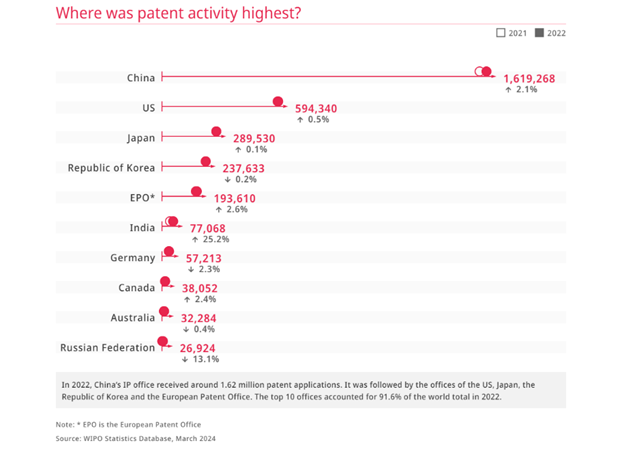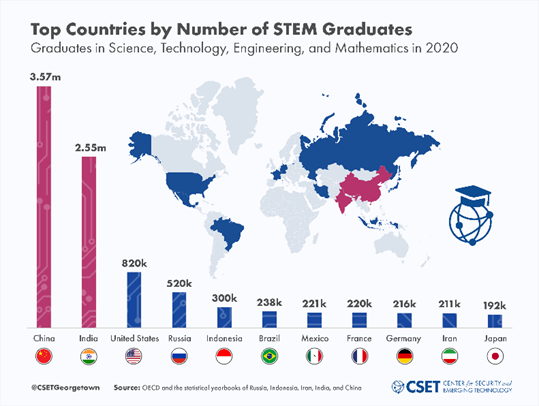Over the past few decades, the global landscape of technological research has undergone an unprecedented transformation. While the United States once dominated this strategic field, China has gradually taken the lead, becoming today’s world leader many critical technologies.
A recent report by the Australian Strategic Policy Institute (ASPI) highlights this important shift, showing that China now leads in about 90% of key technologies, significantly outpacing the United States. This reversal of positions between the two global giants has important implications for the future of innovation, security and the global economy.
A Shift in Global Leadership
For decades, the United States was the undisputed leader in technological research, holding a dominant position in almost all strategic fields. However, since the early 21st century, China has surged ahead, flipping the roles of the two countries. The ASPI report, based on an update of the "Critical Technology Tracker," reveals that China, which led in only 5% of technologies between 2003 and 2007, now leads in 57 of the 64 critical technologies tracked over the past five years. In contrast, the United States, which dominated 94% of these technologies in the early 2000s, now leads in only 11%, representing 7 areas out of the 64.
The ASPI tracker evaluates the competitiveness of countries based on the frequency of citations in the most influential scientific papers in each technological category. This ranking reflects not only the volume of research produced but also its quality and global impact. China's performance in this area has been spectacular, allowing it to take the lead in fields as diverse as quantum sensors, high-performance computing, gravitational sensors, space launch, advanced integrated circuit design and semiconductor fabrication.
Factors Behind China’s Supremacy
China's rise in technological power can be attributed to several interconnected factors. One of the most significant is the country’s large investment in research infrastructure, establishing advanced institutions like the Chinese Academy of Sciences.
This institution, now leading in 31 out of 64 critical technologies, exemplifies China's approach of combining a high volume of research with scientific excellence to dominate strategic fields. As highlighted by the World Bank, China's R&D spending relative to GDP has steadily increased, narrowing the gap with the U.S. from 1.89% to 1.03% in 2020.
In March 2024, the Chinese government announced a further 10% boost in science and technology spending, according to the British Council. Despite this, the U.S. still maintains a significant lead, with $806 billion spent on R&D in 2021, compared to China's $668 billion. Meanwhile, Europe lags behind, with its R&D expenditure 40% lower than China’s, as reported by Science Business.

Another key indicator for assessing R&D output is patent activity, where China leads globally. In 2022, China filed 1,619,268 patents, a 2.1% increase from the previous year. In comparison, the U.S. filed 594,340 patents, marking a 0.5% growth, according to the World Intellectual Property Organization (WIPO). Another important measure of technological leadership is the number of new doctorates produced annually. In 2020, China led with 3.57 million new doctorates, followed by India with 2.55 million, while the U.S. lagged significantly behind with 820,000, as noted by the Center for Security and Emerging Technology.

Moreover, China has leveraged its enormous industrial base to accelerate the transition from research to production. While other countries like the United States still excel in technology commercialization, China is quickly catching up by making colossal investments in manufacturing and industrialization, yet this does not necessarily translate into immediate dominance in production but rather reflects a deliberate effort to close the existing gaps.
However, this growing dominance of China in critical technologies has raised concerns, particularly regarding the concentration of research capabilities in a single country, thus increasing the risk of monopoly. ASPI warns of the risk of a Chinese monopoly in 10 new technologies, especially those with military applications, such as advanced aircraft engines, drones, collaborative robots and satellite positioning and navigation systems. The number of technologies considered at high risk of monopolization has increased from 14 last year to 24 this year, highlighting the accelerating trend.
Global Implications
China’s rapid rise in advanced industries, such as semiconductors and aerospace manufacturing, has significant implications for the global economy and national security, particularly for the United States. The consequences of losing competitiveness in high-value-added sectors differ drastically from losing ground in low-skill industries due to three main reasons, according to an extensive study conducted by the Information Technology & Innovation Foundation (ITIF): barriers to re-entry, the loss of high-paying jobs, and national security risks.
Re-entering low-skill industries is relatively straightforward since they require minimal investment in specialized equipment and expertise. However, advanced sectors, such as semiconductor manufacturing, present far greater challenges. For instance, producing a single dynamic random-access memory (DRAM) chip involves over 1,000 steps, necessitating expensive machinery, specialized labor, and a deep understanding of the production process. Companies must also operate at a loss for an extended period to develop the necessary expertise and economies of scale.
In addition to these barriers, losing market share in advanced industries means the loss of well-paying jobs. For example, salaries in information technology (IT) are, on average, 75% higher than the general U.S. wage, so job losses in these sectors can lead to a substantial long-term reduction in aggregate well-being.
Maintaining dominance in advanced industries is essential for national security. The superiority of the U.S. relies in part on its technological edge, particularly in areas like cybersecurity and intelligence gathering. If the U.S. depends on foreign countries, especially rivals like China, for key technologies, its national security could be at risk.
In response to this shift, some observers believe that the United States may be tempted to concentrate their research in more confidential or classified spaces to protect their advances. However, the report's authors warn that this strategy, though effective in the short term, may not be enough to counter China’s progress. China continues to accelerate its investments in strategic sectors, subsidizing key industries and making technological breakthroughs, meaning that this strategy might not be efficient in slowing China’s momentum.
The International Response
In response to China's rapid technological rise, several countries have taken significant steps to protect their national industries and slow China's growing industrial power. Notably, the United States and Canada have imposed 100% tariffs on electric vehicles (EVs) imported from China.
This aggressive measure is designed to shield domestic automakers from the influx of competitively priced Chinese EVs, which have been bolstered by substantial government subsidies and advancements in battery technology. These tariffs not only aim to protect the local market, but also to reduce dependence on Chinese technology, which has become increasingly integrated into global supply chains.
Additionally, Japan has found itself under international pressure to reconsider its role in supporting China's technological infrastructure, particularly in the semiconductor industry. Japan, which is a key player in the global semiconductor supply chain, has been urged to limit its exports and servicing of semiconductor manufacturing equipment to China.
This equipment is crucial for producing the advanced chips that power everything from smartphones to military hardware. In response, Beijing has issued warnings of economic retaliation, highlighting the fragility of international trade relations in the face of escalating tech rivalry. These developments underscore a broader trend of countries enacting protective measures and trade restrictions in an effort to counterbalance China's expanding influence in critical technology sectors, further intensifying global economic tensions.
